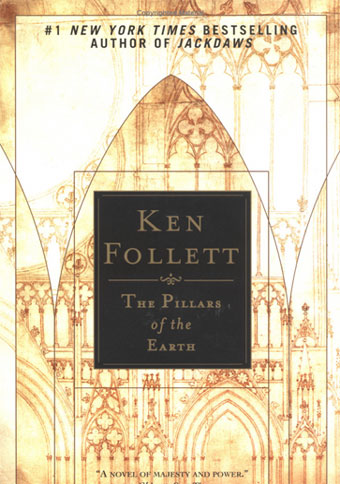Ken Follett
 I had no idea when I started reading Ken Follett’s The Pillars of the Earth that I’d be interested in the building of a church. Yet the plot and counterplots surrounding the lives of the principal characters were so captivating and engrossing that I found myself reading far into the night and early morning, not wanting to put the book down. If you don’t mind a book of nearly a thousand pages (973 to be exact), I promise you will be pleasurably rewarded, for I, like Oprah, upon coming to the end of the 973 pages, wanted more. This is historical fiction at its best, set in Medieval England in the 13th Century, and while it is not always historically accurate—nor is it totally plausible—it is the story of the building of a cathedral, the lifelong dream of a young prior, Brother Philip, a monk who at an unusually young age becomes prior of Kingsbridge upon the death of the elderly prior; and two master builders, Tom Builder, who begins the project with his son Afred, and years later after Tom’s death, his stepson Jack, who completes the project.
I had no idea when I started reading Ken Follett’s The Pillars of the Earth that I’d be interested in the building of a church. Yet the plot and counterplots surrounding the lives of the principal characters were so captivating and engrossing that I found myself reading far into the night and early morning, not wanting to put the book down. If you don’t mind a book of nearly a thousand pages (973 to be exact), I promise you will be pleasurably rewarded, for I, like Oprah, upon coming to the end of the 973 pages, wanted more. This is historical fiction at its best, set in Medieval England in the 13th Century, and while it is not always historically accurate—nor is it totally plausible—it is the story of the building of a cathedral, the lifelong dream of a young prior, Brother Philip, a monk who at an unusually young age becomes prior of Kingsbridge upon the death of the elderly prior; and two master builders, Tom Builder, who begins the project with his son Afred, and years later after Tom’s death, his stepson Jack, who completes the project.
Set in the Middle Ages, this book is very good but sometimes quite implausible. A cathedral seen through the eyes of an eleven-year-old boy who until recently has known only a cave in a forest for home with his young mother. His mother only weeks now has fallen in with a master builder. Tom’s hopes of one day building a cathedral causes him to talk about cathedrals all the time as they travel, looking for work. He and his family have recently become impoverished because of the veritable villains the Hamleighs. Their son, the ubiquitous William—he’s there from the beginning to the end, causing one problem after another for the heroes and heroines—is spurned by the woman he loves, and as a result cancels the building of the home they were to occupy, thus impoverishing Tom and his family.
In their travels in search of work, his pregnant wife Agnes dies after giving birth to another son, and as is sometimes the custom, the baby is left on the grave of its mother to die of exposure rather than of starvation, as there is no way to feed the child. Miraculously, the child is saved and later becomes a major character and sometimes the catalyst to continue the dream of the cathedral, both on the part of the monk and Tom Builder.
Thus eleven-year-old Jack, although quite bright, implausibly learns about cathedrals and their construction. And if this is at least somewhat historically accurate, we enjoy seeing that women in power were quite common in medieval times. But historically accurate or not, seeing women in charge added to the delightful reading. And while we take delight in the accomplishments of our heroes and heroines, we are sometimes disappointed to see the corruption of the Catholic church in all its sordidness.